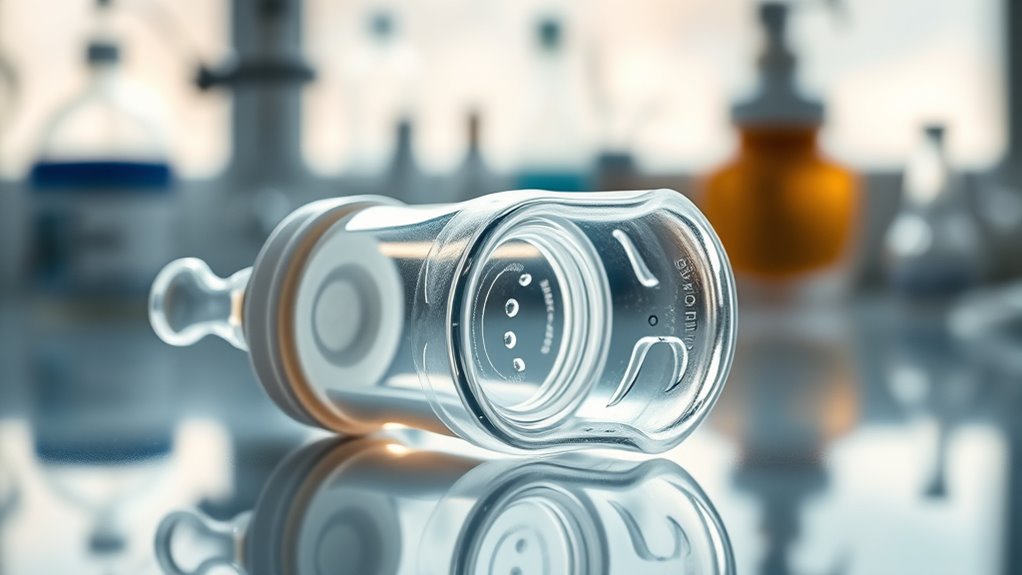Anti-colic bottles work by controlling airflow and milk flow using venting systems and pressure regulation, reducing the amount of air your baby swallows during feeding. They create a balanced environment inside the bottle, minimizing turbulence and the negative pressure that causes gas and discomfort. This scientific design makes feeding smoother and less stressful for your baby. If you want to understand how these features really help ease colic, there’s more to discover about their underlying principles.
Key Takeaways
- Anti-colic bottles use venting systems to regulate internal pressure, reducing the amount of air swallowed during feeding.
- Fluid dynamics principles ensure controlled milk flow, minimizing turbulence and air bubble formation that cause discomfort.
- Proper venting allows air to escape, preventing negative pressure buildup and easing the sucking effort for the baby.
- Scientific studies indicate that these bottles can decrease colic symptoms by reducing swallowed air and gas.
- Their effectiveness depends on correct design and proper use, aligning physics and fluid mechanics to improve feeding comfort.

Many parents turn to anti‑colic bottles to soothe their baby’s discomfort, but understanding the science behind them reveals how they actually work. These bottles are designed to reduce the amount of air your baby swallows during feeding, which is a common cause of colic and gas. To grasp how they function, you need to look at air pressure and fluid dynamics—the principles that govern how liquids and gases move.
When your baby sucks on a regular bottle, they create a vacuum that pulls the milk down from the nipple. If the bottle isn’t designed properly, this vacuum also draws in air along with the milk, which your baby then ingests. Anti‑colic bottles aim to minimize this by controlling how air enters the bottle. They often feature special venting systems or one-way valves that allow air to escape from the bottle as your baby feeds, maintaining a near-neutral pressure environment. This process relies heavily on the concept of air pressure: by equalizing the pressure inside the bottle with the external atmosphere, the amount of air your baby swallows decreases.
Fluid dynamics plays a critical role here. These bottles are engineered to promote smoother flow of milk and prevent sudden bursts or glugs, which can cause your baby to swallow air. The design of the nipple, along with internal venting mechanisms, encourages a steady, controlled flow. This way, the milk moves more predictably, reducing the need for your baby to work harder to draw out the liquid. The gentle, consistent flow aligns with principles of fluid dynamics, ensuring that milk moves efficiently without creating turbulence that might trap air bubbles. Steady flow principles are fundamental to the design, helping to minimize turbulence and aeration during feeding.
The venting system also helps maintain consistent pressure inside the bottle, preventing negative pressure from building up as your baby drinks. When the fluid flows smoothly and air is properly vented, your baby’s sucking effort is less forceful, which can decrease the likelihood of swallowing excess air. This harmony between air pressure and fluid movement means your baby experiences less discomfort, less gas, and potentially less fussiness during feeding. Additionally, innovations in venting technology often utilize pressure regulation to further enhance feeding comfort.
Furthermore, understanding vibrational principles clarifies how these bottles facilitate a gentle feeding process by reducing turbulence and promoting steady flow. In essence, anti‑colic bottles work by applying fundamental physics—balancing air pressure and optimizing fluid dynamics—to create a feeding environment that’s less stressful for your baby. They don’t just rely on the shape or material but on scientific principles that influence how liquids and gases interact during feeding. While no bottle can guarantee complete relief from colic, understanding the science behind these designs helps you see why many parents find them effective in making feeding a more comfortable experience for their little ones.
Frequently Asked Questions
Are Anti-Colic Bottles Safer Than Traditional Bottles?
You might wonder if anti-colic bottles are safer than traditional ones. Generally, they’re designed with BPA-free materials, which makes them safer regarding BPA safety concerns. Plus, their material durability guarantees they withstand regular use without breaking easily. While both types should meet safety standards, anti-colic bottles often offer added features that reduce air ingestion, making feeding more comfortable. Always check labels to ensure BPA safety and quality.
Can Anti-Colic Bottles Reduce Long-Term Digestive Issues?
Imagine you’re in a time machine, wondering if anti-colic bottles can improve your baby’s gut health long-term. While they may reduce gas and discomfort, evidence on preventing future digestive issues is limited. By promoting better feeding habits and minimizing swallowing air, these bottles might support healthier digestion, but they aren’t a guaranteed fix. Focus on proper feeding techniques and consult your pediatrician for the best approach to your baby’s digestive well-being.
How Do Anti-Colic Bottles Compare in Cost?
When comparing anti-colic bottles, you’ll notice pricing differences that reflect features like vent systems and materials. While they often cost more than standard bottles, many parents see the value for money in reducing fussiness and gas. Consider your budget and your baby’s needs; sometimes paying a bit extra offers better long-term comfort and convenience. Ultimately, investing in quality can make feeding easier and more enjoyable for both of you.
Are There Any Potential Drawbacks to Using Anti-Colic Bottles?
You should consider potential drawbacks of anti-colic bottles, such as challenging bottle cleaning due to complex parts or small pieces that trap residue, making thorough sanitation harder. Additionally, some bottles are made from materials that may raise safety concerns if not BPA-free or if they degrade over time. It’s crucial to weigh these factors to guarantee your baby’s health and safety while using anti-colic bottles.
Do Anti-Colic Bottles Work for All Babies?
Oh, sure, anti-colic bottles work wonders—except when your baby’s as stubborn as a mule. You might find they’re not compatible with breastfeeding or that your little one simply prefers a different nipple shape. Every baby is unique, so these bottles aren’t a one-size-fits-all fix. While many parents see relief, others discover that their baby’s preferences or breastfeeding needs mean they’re not the perfect solution.
Conclusion
Remember, anti-colic bottles are like guiding stars in the night sky—aiming to lead your little one away from discomfort. While they can help, they aren’t a magic fix; patience and understanding are your true compass. Trust in the science, but also in your instincts. Each bottle is a small step toward comfort, symbolizing your love and dedication. Together, you and your baby can navigate the journey, finding calm amid the chaos.









